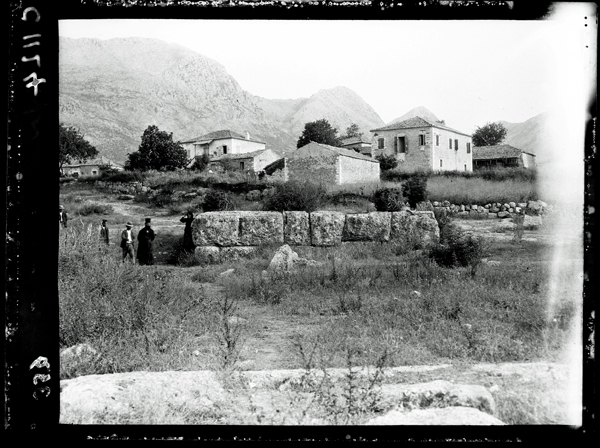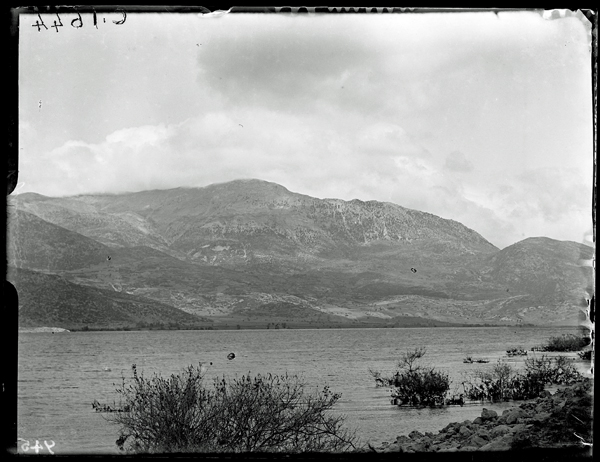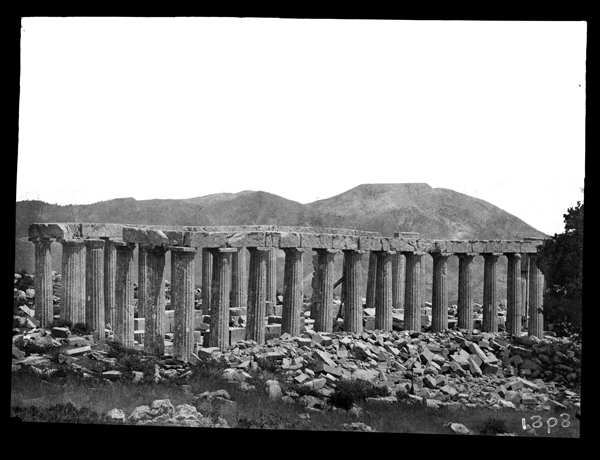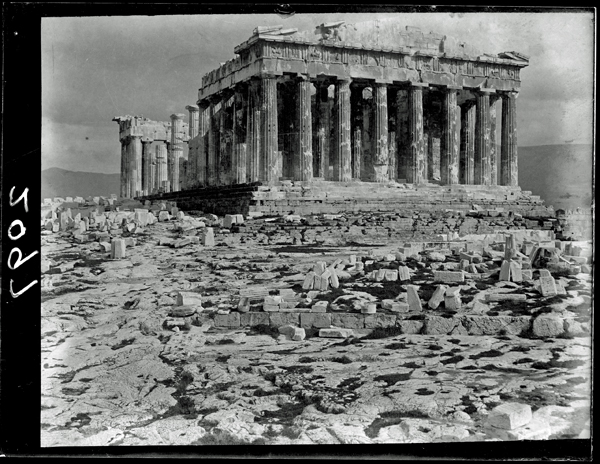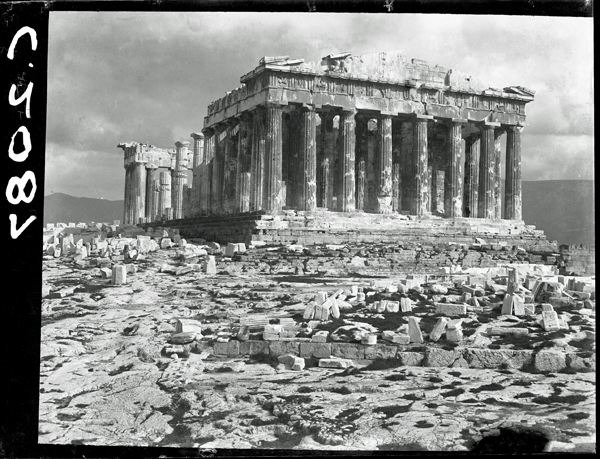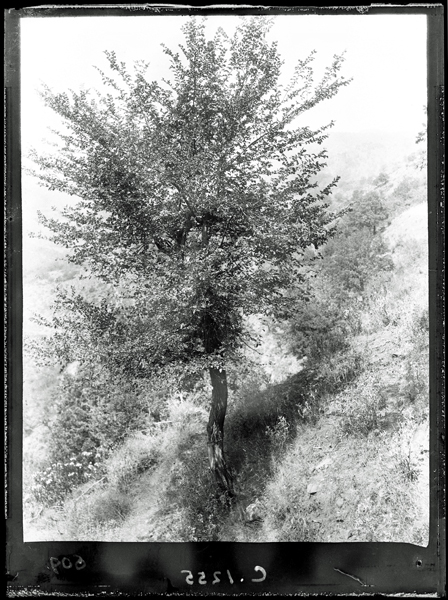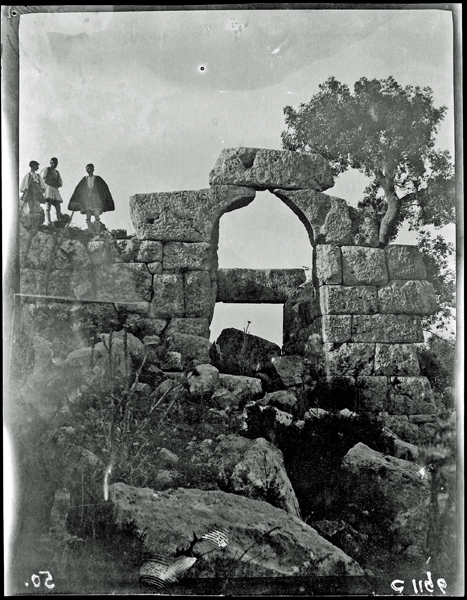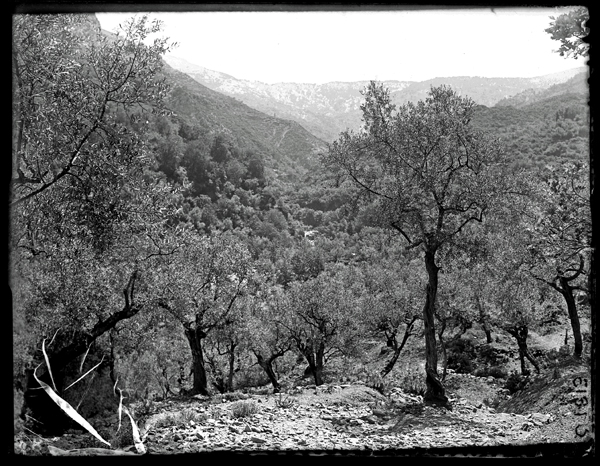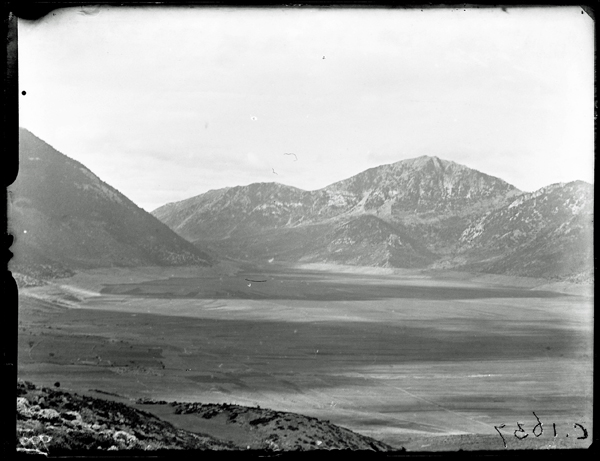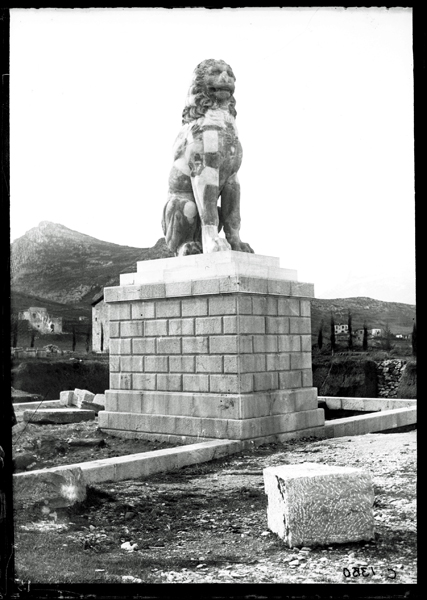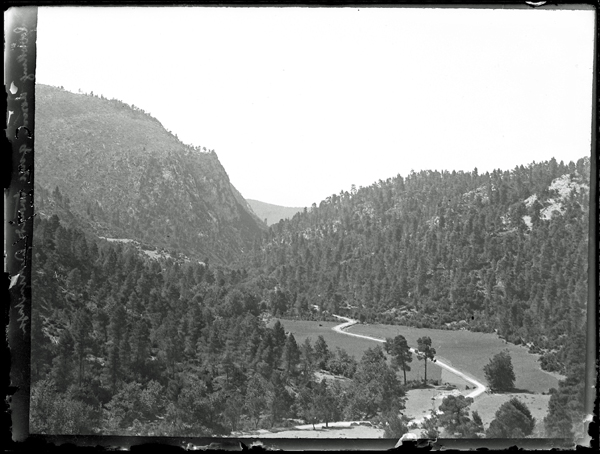A Munificent Donation: Atchley’s topographical photographs in the SPHS Image Collection
By far the most notable addition to the collections during the year has been a munificent donation of over 1000 topographical negatives from Mr. Shirley C. Atchley, of Athens. The larger part of these were taken in Northern Greece and the Peloponnesus, and they embrace several little-known sites. The President transmitted to Mr. Atchley the sincere thanks of the Council and the Society for this important gift. – George Macmillan in the ‘Proceedings: Session 1921-1922’, Journal of Hellenic Studies 42 (1922), p. xxii.
Mr Shirley Atchley is not a household name in Hellenic Studies. He was not a scholar – a Classicist or Archaeologist – but an interested amateur. However, he had an a long and intimate association with Greece, a country he chose to settle in permanently. He first arrived in 1887 from Bristol at the age of 17, less than a year after the British School (BSA) had been established in Athens. By all accounts, Atchley quickly became fluent in Greek, held various jobs based in Greece including positions with the Gresham Insurance Company and the the Ionian Bank. By 1909 he held the position of translator and eventually First Secretary at the British Legation (Embassy) in Athens. He died of heart failure in June 1936 while hiking on Mt. Kyllene in Arcadia. According to his obituary in The Times (Monday, Jun 22, 1936), Atchley was said to have been a keen walker, an amateur botanist, and photographer. His personal collection of photographs were produced during nearly 50 years of his residence in Greece, leading George Macmillan to refer to the donation of a large number of negatives to the Society for the Promotion of Hellenic Studies (SPHS) as ‘munificent’.
Shirley Atchley’s association with the SPHS predates this ‘munificent donation’ in 1921. In the Proceedings of the SPHS for 1913, he is listed a a major donor of negatives to the society’s photographic library, possibly referring to his involvement in brokering a donation of commercial images to the SPHS from the English Photographic Company, a subject of a previous Archive Story. Atchley was also a partner in and photographer for the English Photographic Company and several images from the company match negatives deposited by Atchley in 1921. For example, the image of the Temple of Apollo at Bassae from the English Photographic Company matches that of Atchley’s original film negative which was donated in 1921. The original negative is in a slightly degraded condition, but the English Photographic Company negative has been retouched and cropped, preserving a cleaner image.
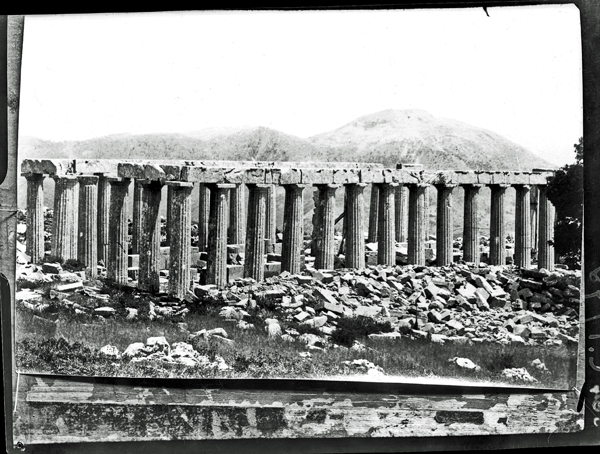
BSA SPHS 01/5984.C1778: Phigaleia [Bassae] temple from NW, 1893, original film negative donated in 1921 (Shirley Atchley)
There are 964 images donated by Atchley now in the BSA SPHS collection that are not associated with the English Photographic Company. The majority of these belong to the 1921 donation. However, at least 5 were given to the SPHS photographic library by Atchley prior to 1921, possibly before or at the same time as the deposit of the English Photographic negatives. They depict ancient monuments (the Parthenon and the Theseum in Athens, the Sanctuary of Alea Athena at Tegea, and the ruins of Aepion near Olympia) and one image of the main town of Corfu. The same image of the Parthenon appears in both the pre-1921 and 1921 donation. The earlier donated image is a glass copy negative, but the one donated in 1921 is the original film negative. The quality of the image on the film negative is marginally clearer and sharper than the earlier donated glass copy negative. Neither appear to have been retouched or cropped.
Most of the negatives donated in 1921 contain Atchley’s personal numbering system, a possible reference to his own photographic register which is not in the SPHS archives. Also, some of the photographs recorded in the SPHS negative register do not currently exist in the BSA SPHS collection and are presumed lost or destroyed during the course of the collection’s history. The existing images, however, represent the geographical areas Atchley covered. It is a vast area of Greece (and a few from Albania and Italy), although some areas are conspicuously absent or only sparsely covered. The two largest groups depict scenes in the Peloponnese and Western Greece.
- 253 Peloponnese
- 241 Western Greece
- 150 Central Greece (Boeotia, Euboea and Phocis)
- 132 Attica
- 108 Epirus (including 12 of Southern Albania)
- 33 Crete
- 31 Ionian Islands
- 6 Aegean Islands
- 5 Thessaly
- 2 Italy
- 3 Unidentified
It is obvious from his many topographical images that he was interested in landscapes and often remarked on vegetation. From 1930 to 1936 he was a registered plant collector for Kew Gardens and wrote a book, Attic Wildflowers, although it was published posthumously. R.M. Dawkins, a former Director of the BSA, wrote a review of Atchley’s wildflower book praising his knowledge of Balkan plant lore and wished that he had been able to accomplish more before his death. Dawkins also remarked that Atchley was well known for his “perambulations”.

BSA SPHS 01/5083.C1018: Zalongogefyro (bridge) over the Zaloggopotamos river, a tributary of Kalamas River
Although the collection contains images of some of the well-known classical monuments and sites, most of the images depict mountainous areas and remote landscapes. This is not surprising for someone noted for his walking expeditions and plant hunting tours. Yet, the images also ’embrace several little-known sites’ as described in the quote above; sites outside the mainstream of classical images that exemplified Greece at the time. This is particularly true in Western Greece where places like Alyzia, Astakos, Kalydon, Limnaea, Old and New Pleuron, Oeniadai, Olpae, Palaeomanina, Palaeros, Phytia, Skourtou, Stratos and others were recorded with his camera.
Soon after the images were deposited with the SPHS, the historian Arnold Toynbee used a number of Atchley’s topographical photographs in his 1924 SPHS illustrated lecture on Greek Geography, originally entitled Greek Life and Greek Environment. The lecture was one of a set of illustrated lectures deposited with the SPHS, part of a scheme, beginning in the 1920s, to promote Hellenic Studies by providing pre-scripted lectures to teachers. The lectures were in the form of typescripts accompanied with lists of slides. Both typescript and slides would have been available for lending to SPHS members.
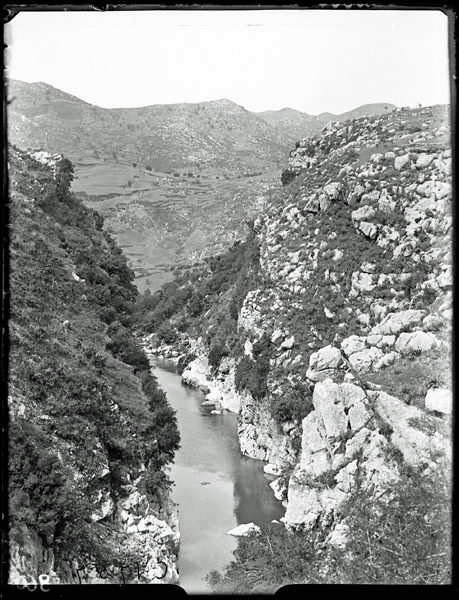
BSA SPHS 01/5964.C1757: View of Alpheios River at the junction of the Lousios River below Karitaina Frankish Bridge; Toynbee’s slide number 7: Subsidence cleft with river flowing through it.
One of the major problems with Atchley’s photographs is assigning dates to them. We know for sure that they pre-date 1921 when the images were deposited in the collection. Although most of the negatives contain Atchley’s own numbering system, we are unable to consult his personal negative register which may have contained more information. Those that we can associate with the English Photographic Company probably date to the last decade of the 19th century. We also have a small number of negatives that include specific dates in their captions. For example, the image of Lake Pheneios below is dated in the caption to May 1914. In other instances, internal evidence in the image itself can be used to deduce an approximate date such as the image of the lion at Chaironeia. The lion monument must date in, or shortly after 1902 when the lion was reconstructed as the image shows the surrounding area by the base still unfinished and the filled in areas of the lion pristine white.
Captions contained in the SPHS register are also another area for scrutiny. These captions were generally recorded by SPHS library volunteers when donations were deposited. It is unclear if they had a written list to help them – possibly Atchley’s own negative register – or simply recorded what was written on the negative although not all negatives have captions inscribed on them. In a few instances, it is clear that the transcribed caption in the negative register was based on a misreading or misunderstanding of the subject of the image. This is not surprising since most of Atchley’s images depict uncharted territory for the SPHS. For example, BSA SPHS 01/6029.C1826 in the negative register refers to ‘Bilati’ which probably refers to the Bilali train station located on the N. end of the Taygetos range; the caption written directly on the negative reads Bilali. Or, BSA SPHS 01/7301.C2274 whose caption in the register reads “Road to Achmet Aga Mycenae”, but the caption on the negative reads “looking down gorge towards Achmitaga”. The entries in the register near C2274 are a mixed lot of images from Atchley (at various places throughout Greece) with no original Atchley numbers attached and cannot help narrow down the location. The site, however, most likely refers to Achmet Aga (modern Prokopi) in Euboea which is supported by the landscape shown in the image.
Another issue is accessibility and the use of the images within the SPHS collection. Only a small number of Atchley’s images were duplicated as slides for public lending in the SPHS Photographic Library. Many of those slides were used for Arnold Toynbee’s lecture on the Geography of Greece. This is, perhaps, due to Atchley’s subject matter. He photographed subjects that, at the time, might not have been deemed appropriate to represent the concept of Hellas. Other than the topographical images chosen by Toynbee, Atchley’s images that were converted to slides, sold or lent to members were of well-known Classical monuments, art or artefacts. This is certainly true of the English Photographic Company images, including many taken by Atchley. But, the English Photographic Company was in the business of providing commercially viable images that represented – and reinforced – the public perception of Greece.
Atchley’s images were marginally appreciated at the time, certainly by Arnold Toynbee. This is not surprising since Toynbee’s eight months at the BSA in the 1911/1912 session were spent studying the historical geography of Greece by travelling (much like Atchley) primarily on foot to remote places. For the most part, however, the majority of Atchley’s images languished in the SPHS photographic collection and were, for all intents and purposes, inaccessible. Yet, Atchley’s photographs are a valuable record of Greek landscapes in the late 19th and early 20th centuries. It is only now, perhaps, that they will live up to their original description of a munificent donation.
Deborah Harlan
British School at Athens
Images from the BSA-SPHS collection are available on the BSA’s Digital Collections page.
Click here for more BSA Archive Stories.
